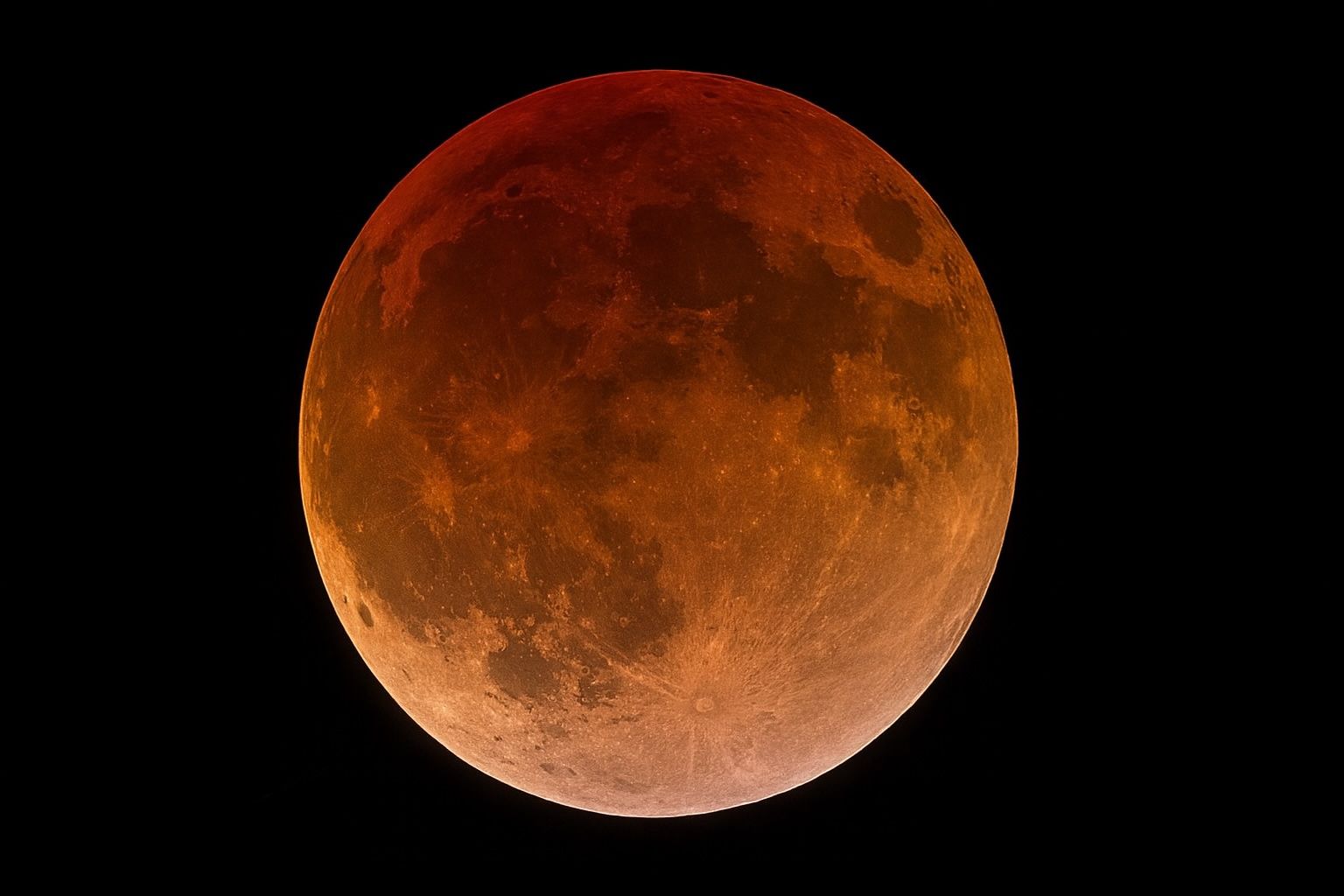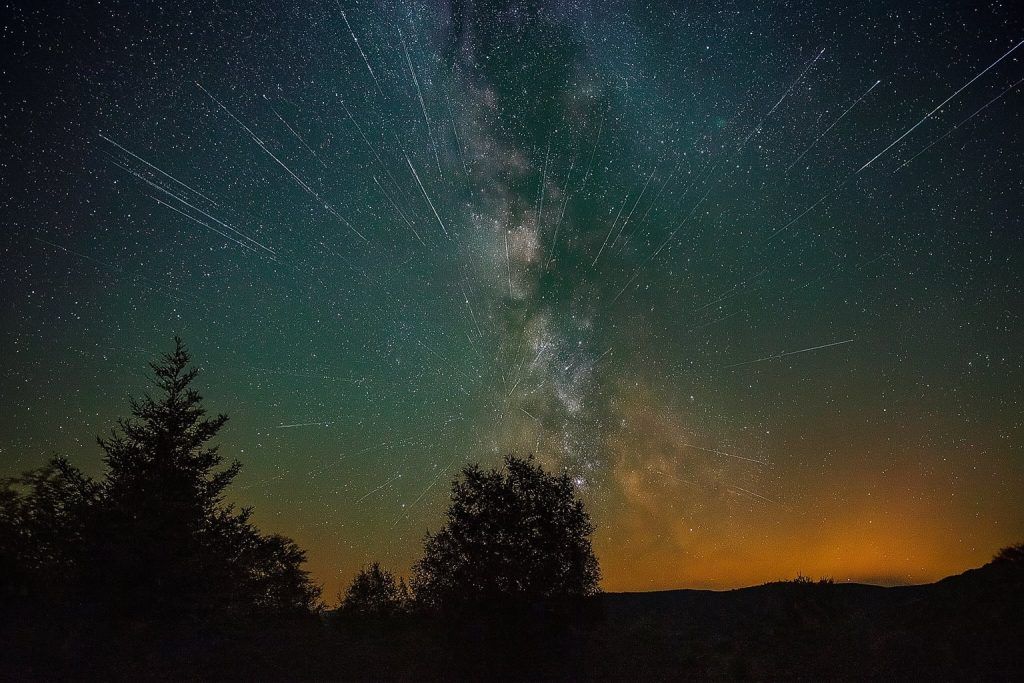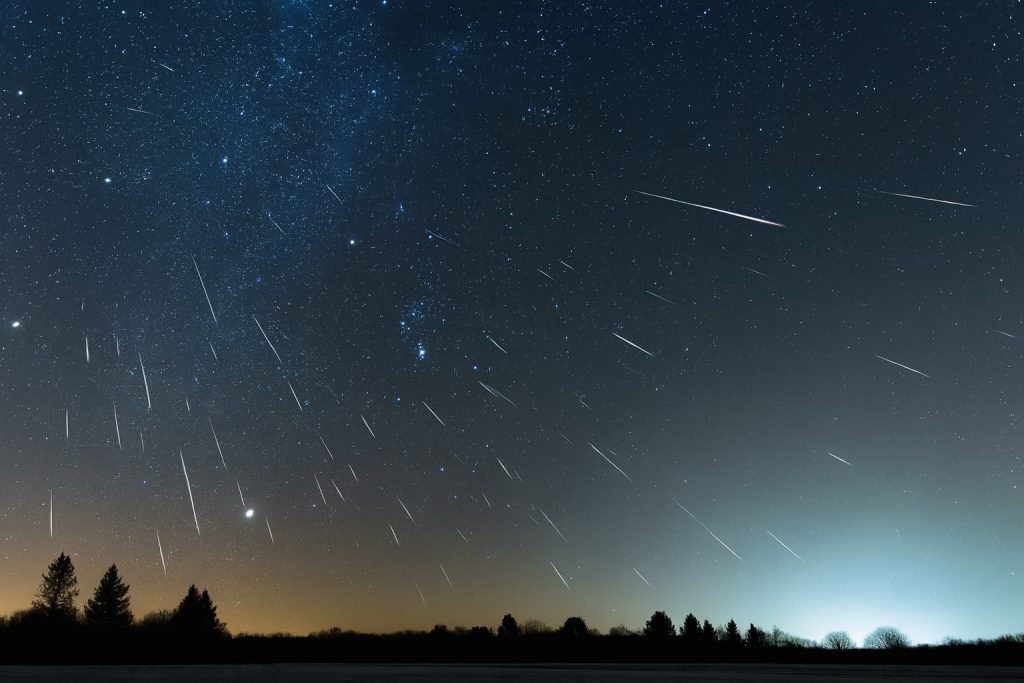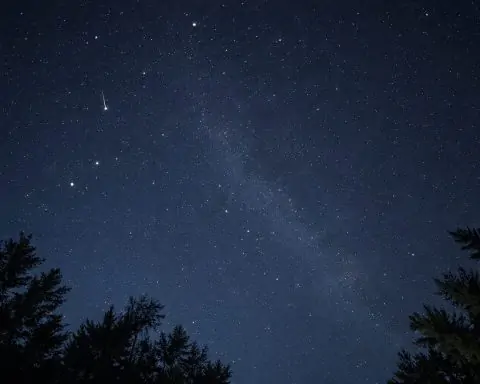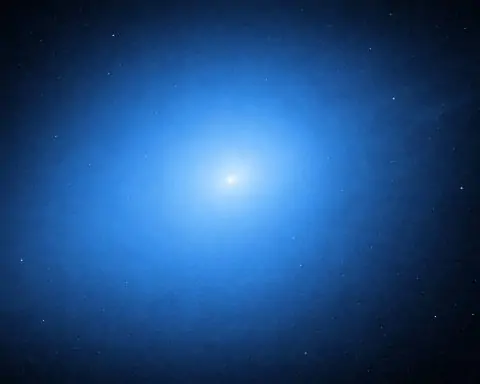- September 7, 2025 features a total lunar eclipse (Blood Moon) with about 83 minutes of totality, visible across Antarctica, Australia, Asia, the western Pacific and Africa, peaking around 18:11 UTC.
- A deep partial solar eclipse on September 21, 2025 reaches about 85% coverage, with maximum at 19:41 UTC and best views from New Zealand and nearby open-ocean regions between NZ and Antarctica.
- Saturn at opposition on September 21, 2025 appears near magnitude 0.6 with its rings tilted about 2° toward Earth, though the ring-plane is almost edge-on this year.
- Venus is occulted by the Moon on September 19, 2025, visible from Africa, Europe, Asia and eastern Canada/Greenland, with London timing around 12:55 PM to 2:14 PM BST.
- Neptune at opposition on September 23, 2025 offers the best chance to observe Neptune in 2025 with a telescope, at magnitude about 7.8 in Aquarius, about 4.3 billion kilometers from Earth.
- Interstellar Comet 3I/ATLAS (C/2025 N1) should remain observable through September 2025, about 11 kilometers across and around magnitude 16, the third known interstellar visitor, before it passes behind the Sun in late October at ~1.4 AU.
- Comet C/2025 K1 ATLAS, a long-period Oort Cloud comet discovered in May 2025, reaches perihelion on October 8, 2025 and may peak near magnitude 5 in early October, potentially visible with binoculars.
- The September 22, 2025 equinox occurs at 23:20 UTC, marking equal day and night worldwide, and the Harvest Moon closest to the equinox shifts to October 7, 2025.
- Moon-planet meetups in September include the Moon–Jupiter conjunction on September 17–18 (Jupiter around magnitude −2.7) and the Moon occulting Antares on September 27.
- The Daytime Sextantids meteor shower runs September 9–October 9, 2025, with a late-September peak around 5 meteors per hour radiating from Sextans near the Sun and best observed around 4–5 AM local time.
Overview – A Month of Cosmic Highlights
September 2025 is set to delight skywatchers around the globe with a feast of celestial events. From a dramatic “Blood Moon” eclipse to a deep partial solar eclipse, from planetary showstoppers to mystical meteor showers, the night (and daytime) sky offers something for everyone. This month brings one of the best views of Saturn, an unusually placed Venus, and even a rare interstellar comet passing through our solar system. Below is a detailed guide to all the major astronomical events and skywatch alerts in September 2025 – so mark your calendars and get ready to look up!
Meteor Showers in September 2025
September’s meteor activity is relatively modest compared to August’s famous Perseids, but dedicated observers can still catch a few shooting stars on clear nights. Three minor meteor showers reach peak activity this month:
- Aurigids (Aug 28 – Sep 5, peak ~Sep 1): This minor shower (about 5–10 meteors per hour at best) peaks around September 1 [1] [2]. The Aurigid meteors radiate from the constellation Auriga in the northern sky and favor observers in the Northern Hemisphere [3]. A half-illuminated moon will be present most of the night, which may wash out fainter meteors [4]. The Aurigids’ parent is Comet Kiess, known to produce occasional outbursts (30–50 meteors/hour recorded in 2007 and 2019) [5] – though none are predicted for 2025.
- September Epsilon Perseids (Sep 5 – 21, peak ~Sep 9): Don’t confuse these with August’s Perseids – the epsilon-Perseids are a different, weaker shower [6]. With a zenithal hourly rate (ZHR) of only ~5 meteors/hour [7], they are subtle. Unfortunately, observing conditions in 2025 are poor, since the peak falls just two days after a bright Full Moon, meaning moonlight will obscure most faint meteors [8]. If you do spot any, they tend to be fast meteors (hitting the atmosphere at ~64 km/s) originating near the star Epsilon Persei in Perseus [9]. Astronomers suspect this shower’s meteoroids come from an unknown long-period comet rather than Comet Swift-Tuttle (the source of the August Perseids) [10].
- Daytime Sextantids (Sep 9 – Oct 9, peak ~late Sep): As the name suggests, this daytime meteor shower has a radiant in the constellation Sextans near the Sun. The meteors are best seen just before dawn in late September [11]. Around its peak (late September, sometimes cited around Sep 27), you might catch a handful of slow-moving meteors (entry speed ~32 km/s) streaking upward from the eastern horizon in the pre-dawn darkness [12] [13]. The Daytime Sextantids are a challenging shower – with rates of only ~5 meteors/hour at best [14] – but keen observers in both hemispheres could spot a few if they watch around 4–5 AM local time when the radiant is just clear of the horizon [15]. (This shower’s particles likely originate from asteroid 2005 UD [16].)
Expert tip: The American Meteor Society notes that casual stargazers may not easily distinguish these minor-shower meteors from random “sporadic” meteors [17]. To improve your chances, observe from a dark location after midnight (when your side of Earth faces into the meteor streams) and try to trace any meteor’s trail backward – if it leads to Auriga, Perseus, or Sextans, you’ve caught one from these showers. And don’t be disappointed by low counts; even a few meteors can make for a memorable night under the stars!
A Blood Moon Rising: Total Lunar Eclipse on September 7
Mark your calendars for the night of September 7, 2025 – a total eclipse of the Moon will grace the skies and turn the Moon a striking reddish hue (hence the nickname “Blood Moon”). This eclipse occurs during the September Full Moon, traditionally called the Full Corn Moon [18].
Where and when to see it
The total lunar eclipse is widely visible across the Eastern Hemisphere. If you’re in India, China, Russia, western Australia, eastern Africa or central Asia, you will get to see the entire eclipse from start to finish [19]. In these regions, the Moon will already be above the horizon as Earth’s shadow completely covers it. Parts of Europe and western Asia will catch the eclipse in progress at moonrise – for example, observers in the U.K. will see a reddened Moon rising just as totality is underway [20] [21]. By contrast, most of North America will miss out on this event (with the exception of perhaps a brief partial phase in Alaska’s far west) [22] [23], since the eclipse happens in daylight hours there.
Timing: The totality (full coverage) lasts for about 83 minutes [24]. According to EarthSky and NASA, the Moon enters Earth’s umbral shadow at 17:30 UTC, reaches the peak of eclipse around 18:11 UTC, and exits the umbra by 18:53 UTC [25]. For those in regions where the eclipse is visible in the evening, this will occur after sunset on September 7; in parts of Asia and Australia, it happens later at night. Be sure to check local timing (sites like timeanddate.com can provide eclipse schedules for your city [26]).
What to expect
During totality, the Moon will likely glow coppery-red or orange. This eerie coloration happens because Earth’s atmosphere bends and filters sunlight, scattering away blue light and letting mainly red hues reach the Moon’s surface [27] [28]. In fact, total lunar eclipses can turn a deep shade of red and are often called a “Blood Moon” [29]. The exact brightness and color can vary depending on how clear or dusty Earth’s atmosphere is at the time (for example, volcanic ash can make eclipses darker). Unlike a solar eclipse, a lunar eclipse is completely safe to view with the naked eye – no protective filters needed [30]. Feel free to also use binoculars or a telescope for a closer look at the red Moon; you might even notice that during totality, with the Moon’s glare reduced, stars and planets (like Saturn, near the Moon in Aquarius during this eclipse) become visible in the sky next to the darkened Moon [31].
“On September 7, 2025, a total lunar eclipse of the Full Corn Moon will sweep across Antarctica, Australia, Asia, the western Pacific, the Indian Ocean, Europe, the eastern Atlantic and Africa,”EarthSky notes, emphasizing the global reach of this event [32]. In other words, a huge swath of the world gets front-row seats to this Corn Moon eclipse. If you’re in the visibility zone, plan to watch as the shadow of Earth creeps across the Moon, transforming it into a rust-colored orb hanging in the night sky – the next total lunar eclipse visible so widely won’t occur until 2026 [33].
Sun Bites Back: Partial Solar Eclipse on September 21
Just two weeks after the lunar eclipse, the New Moon on September 21, 2025 will partially eclipse the Sun. This partial solar eclipse is the second and final solar eclipse of 2025 [34] – and it coincides with the September equinox, making it an “almost-equinox” eclipse. Only certain parts of the Southern Hemisphere will get to see it, so it’s not a worldwide event, but it’s significant for those in the right location.
Where and when to see it
This partial solar eclipse occurs over remote areas of the South Pacific. The best views will be in New Zealand and parts of Antarctica [35] [36]. In New Zealand, depending on location, between about 58% and 73% of the Sun will be covered by the Moon at maximum [37] – a substantial partial eclipse. A thin strip of Australia’s far eastern coast may see a smaller partial eclipse at sunrise on the 22nd (local date) [38]. The maximum eclipse (about 85% of the Sun obscured) happens over open ocean between New Zealand and Antarctica [39], where few people reside. Even the frequently visited Antarctic Peninsula will see only ~12% of the Sun covered near sunset [40]. In summary: most viewers of this eclipse will be in New Zealand (especially South Island) or on ships and research stations in the South Ocean/Antarctica region.
Timing: The partial eclipse begins around 17:29 UTC on Sept 21 and lasts until 21:53 UTC [41]. For New Zealand, this corresponds to the morning of September 22 (since NZST is UTC+12). Maximum eclipse is at 19:41 UTC [42]. Because of time zone differences, in New Zealand the event will occur during the daytime on Monday, September 22. (For example, Auckland might see the eclipse in the late morning local time – detailed local timings can be obtained from sources like TimeandDate [43].)
What to expect and safety
At peak, the Sun will become a brilliant crescent – a significant chunk bitten away by the Moon. Observers in places like Christchurch, NZ, can expect a noticeable drop in brightness and temperature during the maximal 70%-ish coverage. However, even a 70-80% partial eclipse is very bright – never look at the Sun without proper eye protection. Solar eclipse glasses or filters are a must for direct viewing [44]. Pinhole projection or telescope projection methods are also safe ways to observe. (Reminder: Regular sunglasses are NOT sufficient; use ISO-certified solar viewers or filters.)As the nonprofit Prevent Blindness stresses, planning ahead for eye safety is crucial for any solar eclipse – even one visible only to a few communities [45].
Astronomers call this a “deep” partial eclipse because the Moon covers a large area of the Sun at maximum (a magnitude of about 0.85) [46]. It’s not total, but it’s the closest thing to it in 2025 – and it happens one day before the September 22 equinox, an interesting celestial coincidence. In fact, one astronomer quipped that “some remote regions will experience [this] partial solar eclipse on Sunday, Sept. 21, 2025… The best places to see it will be in Antarctica and New Zealand” [47]. If you find yourself in those areas, this is a prime sky event. For the rest of the world, media and science outlets may share images – for instance, expect photos of a crescent Sun over New Zealand’s landscapes. And if you miss it, take heart: the next solar eclipse (a more dramatic total eclipse) will come in August 2026 [48], giving ample time to plan a viewing adventure.
Planetary Highlights: Saturn Shines, Venus Disappears & More
September 2025 also brings planetary treats – notably for Saturn lovers – and some special alignments involving the Moon and planets. Here are the key planetary events to watch for:
- 🔭 Saturn at Opposition (September 21): On the same date as the solar eclipse, Saturn reaches opposition, meaning Earth lies directly between Saturn and the Sun. This places Saturn opposite the Sun in our sky, rising at sunset and visible all night in late September [49]. Around opposition, Saturn is at its biggest and brightest of the year [50], appearing as a golden point of light in the constellation Pisces. Even a small telescope or good binoculars will reveal Saturn’s famous rings and maybe a few moons. However, 2025 is a slightly unusual year for Saturn: its rings are nearly edge-on to Earth. Every ~15 years we view Saturn’s ring-plane edgewise, and in March 2025 the rings turn edge-on and virtually vanish when seen from Earth [51] [52]. By September, the rings are still only tilted ~2° toward us [53] – very narrow, meaning Saturn won’t show the glorious ring span we’ve seen in past years. As space journalist Jamie Carter notes, “2025 is arguably the least-impressive year in over a decade to view Saturn through a telescope,”because the rings line up with our line of sight [54]. Even so, Saturn itself shines at a respectable magnitude ~0.6 at opposition [55] – bright enough to spot with the naked eye – and any view of the ringed planet is still magical. Don’t miss this prime time to enjoy Saturn, rings or not: late August through early October 2025 is ideal for Saturn-gazing when it’s high in the evening sky [56].
- 🌘 Venus Hides Behind the Moon (September 19): In a spectacular bit of celestial choreography, the crescent Moon will occult (cover) Venus on September 19. Venus in 2025 has been shining as the “Morning Star”, visible before sunrise. On this day, the Moon – a thin waning crescent just a few days from new – passes in front of Venus in the daytime sky. The lunar occultation of Venus is visible from large parts of Africa, Europe, Asia, and even eastern Canada/Greenland [57]. For example, in London the event occurs around 12:55 PM BST (daylight, so one would need a telescope and clear skies to observe it) and Venus reappears by ~2:14 PM [58]. Many locations will be in daylight during the occultation, making it a challenging observation – essentially, observers will try to spot Venus and the Moon in the blue sky (binoculars or a small scope can help, with extreme caution never to sweep near the Sun!). If you are in the right place at the right time, the Moon will look like it “swallows” Venus for about an hour or more. Even where the occultation isn’t visible, September 19’s pre-dawn sky will feature a lovely close conjunction of Venus and the Moon, extremely close together just before sunrise [59]. Events like this offer a striking reminder of the solar system’s motion: “In September we’ll get to observe the motion of the solar system in action as Venus takes its turn to temporarily disappear behind the Moon,” note astronomers at the Royal Observatory Greenwich [60].
- 🔵 Neptune at Opposition (September 23): The distant ice giant Neptune reaches opposition on September 23, just two days after Saturn. While Neptune isn’t visible to the naked eye (at magnitude ~7.8), this is the best time in 2025 to locate it with telescopes or binoculars, since it will be relatively bright and above the horizon all night [61] [62]. Neptune lies in Aquarius and appears as a tiny bluish “star.” If you have a telescope, you might also try to glimpse its largest moon Triton (around mag 13.5). Remember that around opposition, Neptune is at its closest to Earth for the year – about 4.3 billion km away! Although Neptune’s opposition is a treat mainly for serious hobbyists, we include it as a global astronomical highlight (especially relevant for astrophotographers and those checking items off their solar system bucket list).
- 🌟 Other Moon-Planet Encounters: Throughout September, the Moon will swing past several bright planets. Notably, on September 17–18 the waning Moon closely pairs with Jupiter in the late night sky [63] [64] – a pretty sight before dawn for early risers. By this time, Jupiter (which reaches its own opposition later in the year) will be shining brilliantly at magnitude around -2.7, and the near-quarter Moon will make a nice guidepost next to it. Earlier in the month, on September 8, the nearly full Moon passed near Saturn (and faint Neptune), and on Sep 10 the Moon was at perigee (its closest point to Earth) [65], creating higher tides (and a slightly larger apparent Moon during the eclipse on the 7th). On September 27, skywatchers in parts of the world also witnessed the Moon occult Antares, the bright red heart of Scorpius [66] – one more occultation in a month that certainly did not lack them! While these moon-planet conjunctions happen frequently, they are still lovely “meet-ups” to enjoy with the unaided eye or binoculars.
Finally, note that Mercury spent much of early September lost in the Sun’s glare, reaching superior conjunction (behind the Sun) on September 13 [67]. By late month Mercury begins to emerge in the evening sky (for observers in the Southern Hemisphere especially). Toward the very end of September or early October, a sharp-eyed observer might catch Mercury low in the west after sunset – but easier Mercury viewing will come in October as it moves further from the Sun.
In short, the planets put on a diverse show in September 2025: a brilliant Venus at dawn (with a dramatic disappearance act), giant Jupiter and ringed Saturn lighting up the night, and distant Neptune making a cameo for those with optical aid. It’s a great month to do some planet-hopping!
Visitor from Beyond: A Rare Interstellar Comet & Other Comets
If meteor showers and planet alignments aren’t enough, September 2025 also offers intrigue in the form of comets – including one truly rare visitor:
- ☄️ Interstellar Comet 3I/ATLAS – Last Chance Before It Fades: In July 2025, astronomers announced the discovery of Comet 3I/ATLAS (C/2025 N1), only the third known interstellar object to enter our solar system [68]. Like ‘Oumuamua (2017) and Comet Borisov (2019) before it, this comet originated outside our solar system entirely – it’s essentially a piece of another star’s planetary system passing through. At about 11 km in diameter, 3I/ATLAS is significantly larger than its interstellar predecessors [69]. Throughout August 2025 it was tracked by telescopes as it brightened to around 16th magnitude [70] – far too dim to see without powerful telescopes, but a target of intense scientific interest. September 2025 is the last window to observe 3I/ATLAS before it goes behind the Sun: “3I/ATLAS should remain visible to ground-based telescopes through September, after which it will pass too close to the Sun to observe,” NASA reported [71]. Indeed, the comet is racing toward a perihelion (closest approach to the Sun) in late October at about 1.4 AU (just inside Mars’ orbit) [72] [73]. By mid-to-late September, 3I/ATLAS will be getting very low in the evening sky and likely unobservable until it reappears in the morning sky by early December [74] [75]. While 3I/ATLAS won’t be a naked-eye comet, it carries enormous scientific value: “These visitors from faraway regions of the cosmos are valuable objects to study since they offer a tangible connection to other star systems,” explained NOIRLab (which released early images of the comet) [76]. They hold clues about the chemistry of other stellar systems and how planets form around other stars. For astronomy enthusiasts with access to telescopes or astrophotography gear, early September was the time to try capturing this interstellar interloper. By late 2025, scientists hope to glean as much data as possible from 3I/ATLAS’s passage before it heads back into interstellar space – likely never to return.
- 🌠 Comet C/2025 K1 (ATLAS) – Brightening in Late September: Another comet generating buzz is C/2025 K1 (ATLAS) – note that despite the similar name, this is a completely different object from 3I/ATLAS. C/2025 K1 is a long-period comet from the distant Oort Cloud, discovered in May 2025 [77]. It’s on its first trip around the Sun and will reach perihelion on October 8, 2025, coming fairly close to the Sun (0.33 AU, within Mercury’s orbit) [78]. This comet has the potential to become a binocular or even naked-eye object around early October. Current forecasts suggest it might peak around magnitude 5 in the first week of October [79] – which would put it in range of easy binocular visibility if those predictions hold. By late September, observers in both hemispheres should try to spot Comet K1 ATLAS low in the sky. Northern Hemisphere: Look in the morning sky before dawn in late September and early October [80]. Southern Hemisphere: You may get views of K1 ATLAS in both the evening and morning during that period [81]. Because the comet passes very close to the Sun, it could brighten rapidly – or it could disintegrate (as “sungrazing” comets often do). Astronomers caution that the comet’s nucleus might be small and fragile, so there’s uncertainty in how bright it will actually get [82]. As of the end of September, the comet is faint (roughly magnitude 12–13) and mainly a telescopic object [83]. But keep an eye out – comets have a way of surprising us! If Comet K1 survives its closest approach to the Sun, late 2025 could treat us to a nice comet in binoculars.
(For completeness, another periodic comet, 210P/Christensen, will reach perihelion in November 2025 around magnitude ~9 [84], and Comet C/2025 A6 (Lemmon) might hit mag 8 in late October [85]. These will be targets in the following months, mostly requiring binoculars or telescopes. September is more of a preparation month for those.)
Equinox and Seasonal Transitions
As the celestial mechanics would have it, September 2025 also marks the change of seasons. The autumnal equinox in the Northern Hemisphere (and spring equinox in the Southern Hemisphere) occurs on September 22, 2025 at 23:20 UTC(which is 7:20 pm BST in London) [86]. On this date, the Sun shines directly over Earth’s equator, and day and night are roughly equal in length worldwide. While not a skywatching “event” in the same sense as an eclipse or meteor shower, the equinox is a global astronomical milestone worth noting. You might notice the Sun rising due east and setting due west on the equinox. Culturally, it marks the beginning of autumn in the north and spring in the south. The full Moon nearest to the September equinox is traditionally called the Harvest Moon, because farmers could work by its light to bring in crops. Interestingly, in 2025 the closest full Moon to the equinox actually falls in early October (Oct 7), so that October full Moon will be designated the Harvest Moon [87] [88]. The September 7 full Moon, as mentioned, is often called the Corn Moon [89], and it dramatically coincided with the total lunar eclipse this year.
As we move past the equinox, nights will lengthen more rapidly in the Northern Hemisphere – meaning more nighttime hours for stargazing. The Milky Way’s dense star fields are still visible on moonless September nights (especially earlier in the month), stretching overhead in the evening. And with the equinox comes the aurora season: around the equinoxes, geomagnetic activity tends to be high, so high-latitude observers might watch for increased aurora borealis and australisdisplays in late September if the Sun happens to flare.
In Conclusion: Don’t Miss September’s Sky Show
From the reddened Moon of the total lunar eclipse to the morning crescents of Venus and the Moon performing a celestial peekaboo, September 2025 offers a rich array of skywatching opportunities. We will witness Earth’s shadow painting the Moon red, see the Sun get partially covered over the South Pacific, enjoy Saturn at its brightest (even as its rings hide in plain sight), and perhaps catch a falling star or two on late summer nights. Plus, the story of a far-traveling interstellar comet reminds us that our solar system is not isolated – sometimes pieces of other worlds pay us a visit.
As always, for any planned observations, check the local forecast and try to find dark skies away from city lights. Many events (like the eclipse and meteor showers) don’t require any optical aid – just your eyes and patience. For events involving the Sun (the solar eclipse, Venus occultation in daylight), exercise caution and use proper filters or indirect viewing methods [90]. And if you’re clouded out or not in the visibility zone, you can tune into online streams or social media, where astronomers often share images in real time.
September 2025 truly has a bit of everything for astronomy enthusiasts. In the words of the Royal Observatory astronomers, this year’s sky highlights “feature exciting sights, from partial solar and total lunar eclipses to illuminated planets, meteor showers, supermoons and more.” [91] So keep looking up – the cosmos is putting on a show, and everyone on Earth is invited. Clear skies and happy skywatching!
Sources:
- EarthSky – Total lunar eclipse of the Full Corn Moon, September 7, 2025 [92] [93]
- BBC Sky at Night – Blood Moon lunar eclipse on Sept 7, 2025 (visibility regions) [94]
- EarthSky – A deep partial solar eclipse September 21, 2025 [95] [96]
- Space.com – Partial solar eclipse Sept 21, 2025 (Antarctica & NZ visibility) [97] [98]
- Royal Observatory Greenwich – September 2025 astronomy highlights [99] [100]
- EarthSky – Saturn at opposition (closest and brightest) [101]
- Space.com – Saturn at opposition 2025 and rings edge-on [102]
- EarthSky – Venus occultation commentary (Jake Foster, ROG) [103]
- NASA Science – Interstellar Comet 3I/ATLAS discovered (visibility through Sept) [104]
- EarthSky – Interstellar comet 3I/ATLAS details and quotes [105] [106]
- BBC Sky at Night – Interstellar comet 3I/ATLAS overview [107]
- StarWalk (Vito Technology) – Meteor Showers in Sept 2025 (Aurigids, ε-Perseids, Sextantids) [108] [109]
- StarWalk – Upcoming Comets (C/2025 K1 ATLAS potential magnitude) [110] [111]
- American Meteor Society – 2025 Meteor Shower List (minor showers info) [112] [113]
- Space.com – 15 must-see skywatching events in 2025 (eclipse and Saturn info) [114] [115]
- Royal Observatory Greenwich – Explanation of Harvest Moon [116] and seasonal note [117].
References
1. starwalk.space, 2. starwalk.space, 3. starwalk.space, 4. starwalk.space, 5. starwalk.space, 6. starwalk.space, 7. starwalk.space, 8. starwalk.space, 9. starwalk.space, 10. starwalk.space, 11. starwalk.space, 12. starwalk.space, 13. starwalk.space, 14. starwalk.space, 15. starwalk.space, 16. starwalk.space, 17. www.amsmeteors.org, 18. www.skyatnightmagazine.com, 19. www.skyatnightmagazine.com, 20. www.rmg.co.uk, 21. www.rmg.co.uk, 22. www.skyatnightmagazine.com, 23. www.skyatnightmagazine.com, 24. earthsky.org, 25. earthsky.org, 26. earthsky.org, 27. www.skyatnightmagazine.com, 28. www.skyatnightmagazine.com, 29. earthsky.org, 30. www.skyatnightmagazine.com, 31. earthsky.org, 32. earthsky.org, 33. science.nasa.gov, 34. www.space.com, 35. www.space.com, 36. earthsky.org, 37. www.space.com, 38. www.timeanddate.com, 39. www.space.com, 40. www.space.com, 41. earthsky.org, 42. earthsky.org, 43. www.space.com, 44. earthsky.org, 45. preventblindness.org, 46. m.economictimes.com, 47. www.space.com, 48. www.space.com, 49. earthsky.org, 50. www.almanac.com, 51. earthsky.org, 52. earthsky.org, 53. earthsky.org, 54. www.space.com, 55. starwalk.space, 56. earthsky.org, 57. www.rmg.co.uk, 58. www.rmg.co.uk, 59. www.space.com, 60. www.rmg.co.uk, 61. in-the-sky.org, 62. in-the-sky.org, 63. in-the-sky.org, 64. in-the-sky.org, 65. in-the-sky.org, 66. in-the-sky.org, 67. in-the-sky.org, 68. earthsky.org, 69. earthsky.org, 70. earthsky.org, 71. science.nasa.gov, 72. science.nasa.gov, 73. www.skyatnightmagazine.com, 74. earthsky.org, 75. www.skyatnightmagazine.com, 76. earthsky.org, 77. starwalk.space, 78. starwalk.space, 79. starwalk.space, 80. starwalk.space, 81. starwalk.space, 82. starwalk.space, 83. aerith.net, 84. www.timeanddate.com, 85. starwalk.space, 86. www.rmg.co.uk, 87. www.rmg.co.uk, 88. www.rmg.co.uk, 89. www.skyatnightmagazine.com, 90. earthsky.org, 91. www.rmg.co.uk, 92. earthsky.org, 93. earthsky.org, 94. www.skyatnightmagazine.com, 95. earthsky.org, 96. earthsky.org, 97. www.space.com, 98. www.space.com, 99. www.rmg.co.uk, 100. www.rmg.co.uk, 101. earthsky.org, 102. www.space.com, 103. www.rmg.co.uk, 104. science.nasa.gov, 105. earthsky.org, 106. earthsky.org, 107. www.skyatnightmagazine.com, 108. starwalk.space, 109. starwalk.space, 110. starwalk.space, 111. starwalk.space, 112. www.amsmeteors.org, 113. www.amsmeteors.org, 114. www.space.com, 115. www.space.com, 116. www.rmg.co.uk, 117. www.rmg.co.uk
